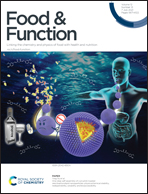First morphological-level insights into the efficiency of green tea catechins and grape seed procyanidins on a transgenic mouse model of celiac disease enteropathy†
Abstract
Alternative or complementary treatments to a gluten-free diet are urgently needed for Celiac Disease. By exploiting the health-promoting properties of polyphenols on a transgenic mouse model of Celiac Disease enteropathy, this study provides the first in vivo evidence regarding the ability of 1 mg day−1 doses of green tea catechins and grape seed procyanidins to ameliorate some of the most characteristic histological changes of gliadin-treated DQ8 mice, including villus flattening, crypt hyperplasia, and infiltration of intraepithelial lymphocytes. Mechanistically, polyphenols were found to increase the intestinal nucleophilic tone of DQ8 mice by orchestrating an adaptive antioxidant response characterized by enhanced GSR enzyme activity and GSH content. Taken together, this work constitutes a highly relevant breakthrough as it provides the fundamental basis concerning the significance of natural polyphenols to be used in, for instance, the development of innovative functional foods aimed at CD individuals.


 Please wait while we load your content...
Please wait while we load your content...